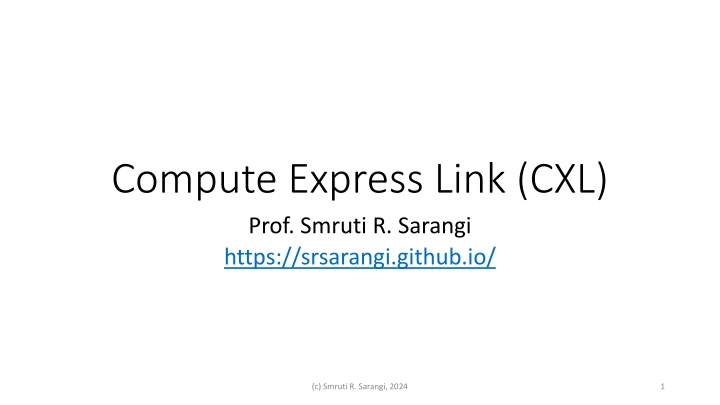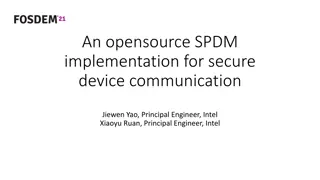
CXL Protocol - Overview of Express Link with Smruti R. Sarangi
Explore the Compute Express Link (CXL) protocol and its evolution managed by a consortium since 2019. Learn about its I/O semantics, benefits, and comparison with PCI-Express technology. Discover why CXL is essential for coherent memory access and data sharing in modern computing. Dive into the technical details of PCI Express and its usage in motherboards for efficient data transfer.
Download Presentation

Please find below an Image/Link to download the presentation.
The content on the website is provided AS IS for your information and personal use only. It may not be sold, licensed, or shared on other websites without obtaining consent from the author. If you encounter any issues during the download, it is possible that the publisher has removed the file from their server.
You are allowed to download the files provided on this website for personal or commercial use, subject to the condition that they are used lawfully. All files are the property of their respective owners.
The content on the website is provided AS IS for your information and personal use only. It may not be sold, licensed, or shared on other websites without obtaining consent from the author.
E N D
Presentation Transcript
Compute Express Link (CXL) Prof. Smruti R. Sarangi https://srsarangi.github.io/ (c) Smruti R. Sarangi, 2024 1
CPU Device CPU Memory History Formed by Intel 2019 Now managed by a consortium Three generations of specifications: 1.0, 2,0, 3.0 Uses PCIe as the base physical layer (c) Smruti R. Sarangi, 2024 2
Introduction to CXL I/O semantics: CXL.io Dynamic multi-protocol technology Caching protocol: CXL.cache Device memory access: CXL.mem CXL is a protocol that is built on top of PCIe (PCI Express) Network interfaces Accelerators Memories Persistent Memory Cores (c) Smruti R. Sarangi, 2024 3
Why CXL? Coherent access to host/device memory Scalable memory: PCIe is 5X faster than DDR Pool memory by using remote memory Fine-grained data sharing: leverage local accesses (c) Smruti R. Sarangi, 2024 4
Outline Power, Security, Reliability Background and Overview Switching Link Layer Transaction Layer
PCI Express Motherboards needs a bus to connect the I/O elements There were many buses in use in the late nineties. Two of them were very popular. PCI (Peripheral Component Interconnect) AGP (Accelerated Graphics Port) A standardisation effort led to the PCI-Express (PCI-X) bus A PCI Lane is a : High speed serial bus. Does not use parallel links because of the possibility of different amounts of delay across the links. Synchronisation across links is difficult. Full duplex comm: 3.94 GB/s (serial lane), 7.56 GB/s (3.x) (c) Smruti R. Sarangi, 2024 6
PCI Express (Peripheral Component Interconnect Express) Usage As a mother board bus Specification PCI Express specifications (link) Topology Connection Point to point with multiple lanes Lane A single bit full duplex channel with data striping Number of Lanes 1 to 32 Physical Layer Signalling LVDS based differential signalling Encoding 8 bit/10 bit Timing Source synchronous Data Link Layer Frame Size 128 bytes Error Correction 32-bit CRC Transactions Split transaction bus Bandwidth 8 GB/s per lane (approx.) (version 6.0) Network Layer Routing Nodes Switches (c) Smruti R. Sarangi, 2024 7
Flex Bus Choose between native PCIe and CXL CXL Switch CPU CPU/memory/accelerator PCIe CXL CXL card PCIe card Switch CXL accelerator (c) Smruti R. Sarangi, 2024 8
FlexBus Layers cache and mem Transaction Layer PCIe/CXL.io Trans. Layer PCIe/CXL.io Data Link Layer cache and mem Link Layer ARB/MUX Logical Layer Electrical Layer (c) Smruti R. Sarangi, 2024 9
Example CXL System Host Accelerator Logic Device Memory I/O Devs Core Core Mem Ctrl. Caching logic DTLB Mem Ctrl. PCIe and CXL Coherence + Mem logic CXL.io CXL.mem CXL.cache Host Memory CXL (c) Smruti R. Sarangi, 2024 10
Types of CXL Devices Type 1 device: Rely on the host s memory Need a fully coherent cache to access the host s memory Supports devices using the cxl.cache link layer: devices can cache host memory Any memory consistency model can be implemented on top of it. Special feature: Unlimited number of atomic operations Type 2 device: Local memory + host s memory Support all three protocols: io, cache and mem They additionally have memory (DDR, HBM, etc.) The device has cache + memory (device-managed coherence) The device memory can be private to it, or it can be shared with the host (c) Smruti R. Sarangi, 2024 11
Type 3 CXL Device Supports the CXL.io and CXL.mem protocols Does not operate on host memory Serve as a memory expander No compute elements Instead of participating in cache coherence, it services requests sent from the host (c) Smruti R. Sarangi, 2024 12
Comparison of all Three CXL Memory Devices Type 1 Type 2 Type 3 Purpose Accelerator Accelerator with local memory Memory expander Local memory Coherence No (mostly) Yes Yes Yes (host) Yes (host + local) No Protocols io and cache io, cache and memory io and memory Use case Network adapter, compression engine GPUs, AI/ML accelerators Persistent memory, DRAM modules (c) Smruti R. Sarangi, 2024 13
Complex Interconnections + Virtualization Multi-Logical Device (MLD) 1 Device 16 Isolated Logical Devices Each logical device has a Logical Device Identifier (LD-ID) Pooled Memory and Shared Fabric 1 Device Memory Exposed to multiple hosts Can use a single link or multiple links Matrix connection between logical devices and memories (c) Smruti R. Sarangi, 2024 14
A Head is a CXL port on a Type 3 device Example Topology Head 0 Head 1 Head 2 LD0 LD1 LD2 LDn Pooled Memory (c) Smruti R. Sarangi, 2024 15
CXL Fabric Host Host Host Acc Switch Switch Switch Switch Memory Expander Acc MLD (c) Smruti R. Sarangi, 2024 16
Outline Power, Security, Reliability Background and Overview Switching Link Layer Transaction Layer
CXL.cache Bidirectional caching D2H Request Response H2D Data The granularity of data transfer is always 64 bytes Snoops to maintain coherence (H2D or D2H) The channels operate independently (deadlock potential) There can be no assumption made on the delivery times of messages The sender may run out of link-layer credits (c) Smruti R. Sarangi, 2024 19
Host and Device Bias Host bias The host manages the coherence. Device bias The device manages the coherence. The host needs permission from the device to access the block. Bias Table Tracks bias data at the granularity of pages Allows bias transitions (c) Smruti R. Sarangi, 2024 20
Always ask the host for coherence info. Ex: Host Bias Device Host CXL Coherence logic Coherence logic Host-managed device memory Host attached memory (c) Smruti R. Sarangi, 2024 21
Device to Host Requests (Upstream) CXL.cache Read (Device wants to read from the host) Request Response Data (2 x 32 bytes) CXL.cache Read0 Device Coherence Engine (DCOH) Do not receive any data messages after the response Examples: cache flush (zero the data, relevant in persistent memory and atomics) CXL.cache Write (host asks the device to send the write) Request Response (GO and WritePull) Data Device let s go of ownership first and then forwards the data CXL.cache Read0-Write First zero the data on the host, and then write to it (c) Smruti R. Sarangi, 2024 22
Host to Device Responses Downstream WritePull Host needs to get the data from the device GO messages Global Observation message. Coherence message. Locks the host until the transaction is over (avoid race conditions) An orderly transfer of ownership is ensured. Otherwise race conditions will lead to errors. Only one snoop pending per cache line Multiple reads, evicts and writes to the same cache line are strictly regulated Only one outstanding evict per cache line. Multiple reads are fine. Preferably, single write. The GO message establishes the ordering (c) Smruti R. Sarangi, 2024 23
Example Device to Host Interaction Device Host (c) Smruti R. Sarangi, 2024 24
Host to Device: Snoop Requests SnpData SnpInv Read requests (no ownership) Transition to shared, send data Require ownership Meant for write requests Leads to invalidations SnpCur Get current version of the line No change in the cache state (c) Smruti R. Sarangi, 2024 25
Example Interaction: Host to Device Device Host Wait for the data (c) Smruti R. Sarangi, 2024 26
Device to Host Response Mnemonic Meaning RspIHITI Line not found RspVHITV Hit and no state change RspIHITSE Hit (not modified), now cleared RspSFWDM RspIFWDM Downgraded to shared Modified Invalid transition at the device Returning the current data RspVFWDV (c) Smruti R. Sarangi, 2024 27
CXL.mem Subordinate Master CXL.mem Memory CPU (transactional interface) The memory controller can be on the host CPU, device or on a separate chip CPUs and other CXL devices can access device memory HDM-H: Host-only coherent (Type 3 devices) HDM-D: Device coherent (Type 2 devices) HDM-DB: Device coherent using back-invalidate (Type 2 or 3 devices) Back-invalidate: other cached copies are invalidated (c) Smruti R. Sarangi, 2024 29
M2S and S2M Transactions M2S S2M Request without data Response without data Request with data Response with data Back-invalidate response Back-invalidate snoop Snoop filter Which address is cached where? Device (c) Smruti R. Sarangi, 2024 30
Transaction Ordering There are strict rules for ordering transactions in the D2H and H2D links. Snoops cannot overtake earlier GO messages Back-invalidate snoop: The device snoops the host (and possibly invalidates it) Examples (c) Smruti R. Sarangi, 2024 31
Scenario 1: Simple snoop request (Type 1 and Type 2 devices) Host DCOH Device Rd addr. X SnpData Hit shared Data + Response Cmp (complete) Data X (c) Smruti R. Sarangi, 2024 32 32
Scenario 2: Inv snoop request (Type 1 and Type 2 devices) Host DCOH Device Rd X + SnpInv SnpInv Hit Invalidate Data + Response Cmp (complete) Data X (c) Smruti R. Sarangi, 2024 33 33
Scenario 3: Non-cacheable Read (Type 1 and Type 2 devices) Host DCOH Device Rd X + SnpCur SnpCur Hit Data + Response Cmp (complete) Data X (c) Smruti R. Sarangi, 2024 34 34
Scenario 4: Direct Write from Host Host DCOH Device Dev Mem Wr, SnpInv Write Miss Cmp Cmp (c) Smruti R. Sarangi, 2024 35 35
Scenario 5: Weakly Ordered Write Host DCOH Device Dev Mem Wr, SnpInv SnpInv Hit Invalidate Data + Response Write Cmp Cmp (c) Smruti R. Sarangi, 2024 36 36
Scenario 6: Device Read to Device-Attached Memory Host DCOH Device Dev Mem RdAny Host bias RdForward Read Device bias Data Data Device bias RdAny Read Subsequent reads Data Data (c) Smruti R. Sarangi, 2024 37
Scenario 7A: Device Write to Device Memory (Device Bias) Host DCOH Device Dev Mem Device bias Write WrPull Data Write Cmp Cmp (c) Smruti R. Sarangi, 2024 38 38
Scenario 7B: Device Write to Device Memory (Host Bias) Host DCOH Device Dev Mem Host bias WrBack WrPull Data Data Write Cmp Cmp (c) Smruti R. Sarangi, 2024 39 39
Scenario 8: Miss in the Snoop Filter Device Mem. Peer cache Host DCOH Rd X Rd X BISnp Y SnpInv Y Invalidate Data X Data + response Wr Y Wr Y Cmp (complete) Cmp Data X X displaces Y (c) Smruti R. Sarangi, 2024 40
QoS Telemetry Req. Memory device QoS Response Each memory device indicates its current load level (DevLoad) along with every response Load balancing, power management, request rate throttling QoS Light Optimal Moderate Severe Multiple QoS classes Memory device Performance isolation (c) Smruti R. Sarangi, 2024 42
How is Telemetry Used? Devices can themselves take breaks and perform maintenance tasks: refresh, wear levelling, etc. Dynamic feedback-based control. LoadMax (sent by memory device) Level of Request Throttling Light Optimal Moderate Severe Adjust ever T ns. T is slightly more than the host->device->host round-trip time Conflict Flow control at the egress port also exerts some back-pressure. (c) Smruti R. Sarangi, 2024 43
Flow Control vs Device Load Consider a clogged egress port When the device s request queue length is increasing Responses take more time The device s load is high Severe or Moderate Load messages take longer to send The host does not throttle the traffic on time This leads to more messages and the queue filling up even faster A reverse effect happens when the queue length decreases Light Load messages take a long time to reach the host The queue drains even faster Include egress port information in the QoS data (c) Smruti R. Sarangi, 2024 44
CXL.io Address translation Device discovery Status reporting DMA Uses non-coherent I/O load semantics For all devices, CXL.io is mandatory Supports strict ordering like sequential consistency (relaxed in CXL 3) Three flow-control classes: writes (P), reads and config messages (NP) and completions (C) Writes and reads may bypass reads Need two virtual channels for ensuring QoS (c) Smruti R. Sarangi, 2024 46
Software Support The firmware lists and configures CXL resources at boot time Many such devices are assigned host physical address ranges These are often memory devices, and cannot be removed seamlessly Coherent Device Address Table Internal NUMA domains Memory ranges Bandwidth Latency Support hot addition and removal (c) Smruti R. Sarangi, 2024 47
Outline Power, Security, Reliability Background and Overview Switching Link Layer Transaction Layer
Link Layer Intermediate stage between CXL.io and Flex Bus Runs on top of the PCIe Data Link Layer 68B (used with CXL.io) and 256B modes available 66B in the link layer and 2 bytes in the ARB/MUX layer Physical layer support up to 32 GT/s 256B supports any legal transfer rate (>32 GT/s) Standard supports only x16 links and higher The framed I/O packet is forwarded to the Flex Bus Layer (c) Smruti R. Sarangi, 2024 49
cxl.cachemem Flit size: 528 bits (66 bytes) Flit header (4 B) 16-B Generic Slot 12-B Header 16-B Generic Slot 16-B Generic Slot 16-B Generic Slot 16-B Generic Slot 16-B Generic Slot 16-B Generic Slot CRC (2 B) CRC (2 B) Protocol flit Data flit (c) Smruti R. Sarangi, 2024 50



